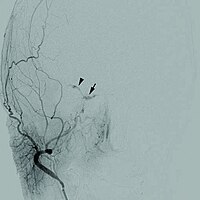
Photo from wikipedia
BACKGROUND AND OBJECTIVES Pediatric cerebrovascular disease carries significant morbidity and mortality. Early recognition of a pediatric stroke as well and its most common risk factors are important, but that diagnosis… Click to show full abstract
BACKGROUND AND OBJECTIVES Pediatric cerebrovascular disease carries significant morbidity and mortality. Early recognition of a pediatric stroke as well and its most common risk factors are important, but that diagnosis is often delayed. It is believed that the incidence in our center is higher than it appears. This study aims to assess the incidence and characteristics of the pediatric stroke in our university hospital. Likewise, this study seeks to evaluate if a longer symptoms-to-diagnosis time is associated with mortality in patients with ischemic stroke. METHODS A retrospective study including children with stroke admitted to the UANL University Hospital from January 2013 to December 2016. RESULTS A total of 41 patients and 46 stroke episodes were admitted. About 45.7% had an ischemic stroke and 54.3% had a hemorrhagic stroke. A mortality of 24.4% and a morbidity of 60.9% were recorded. Regarding ischemic and hemorrhagic stroke, an increased symptoms-to-diagnosis time and a higher mortality were obtained with a relative risk of 2.667 (95% confidence interval [CI]: 1.09-6.524, p = 0.013) and 8.0 (95% CI: 2.18-29.24, p = < 0.0001), respectively. A continuous increase in the incidence rate, ranging from 4.57 to 13.21 per 1,000 admissions comparing the first period (2013) versus the last period (2016), p = 0.02, was found in our center. CONCLUSIONS Pediatric stroke is a rare disease; however, its incidence shows a continuous increase. More awareness toward pediatric stroke is needed.
Journal Title: Neuropediatrics
Year Published: 2021
Link to full text (if available)
Share on Social Media: Sign Up to like & get
recommendations!